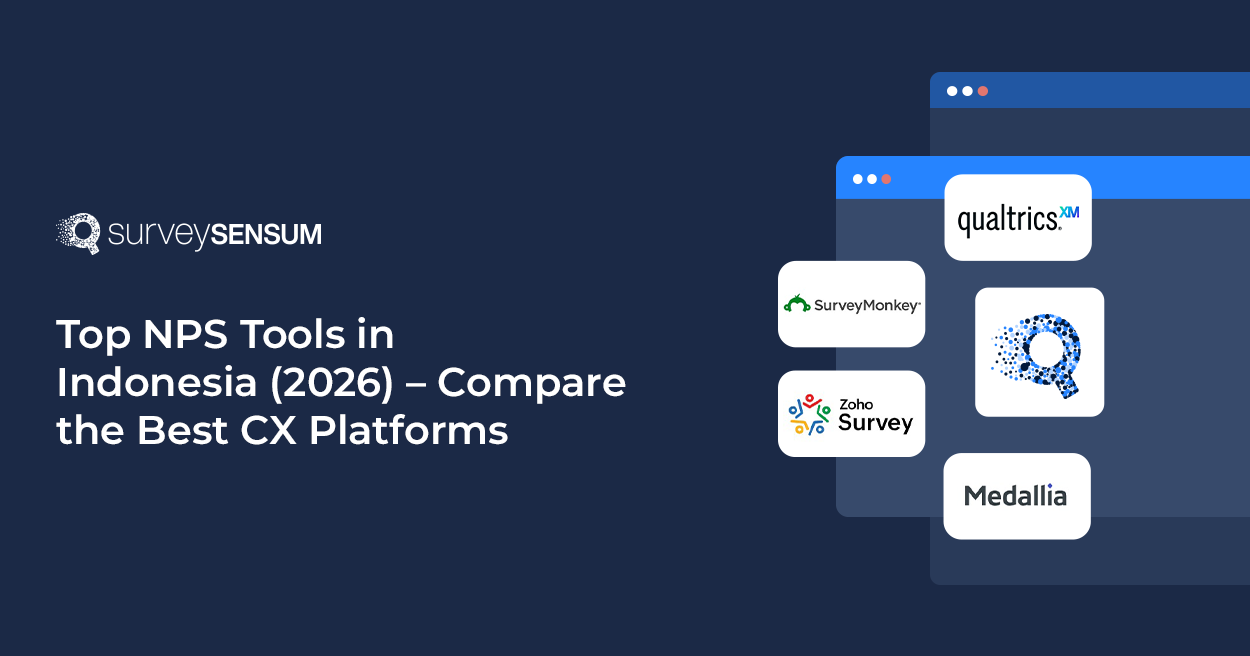

Why do you need to measure the ROI of your CX program?
To answer simply, how are you going to design, measure, and optimize your CX program if you don’t know its return on investment?
And if you are making an investment, you need to make sure that there is a defined and forecasted return on that investment.
CX leaders often face challenges in quantifying the ROI of their CX program to make a strong business case for the boardroom. They need to show how their CX program has resulted in positive ROI and quantifiable business results to get the stakeholders of the company on board to get continued funding.
Did you know how many CX leaders were able to secure their CX budget in 2021?
Only one-third!
That is why calculating the ROI of your CX program is an important factor. And if you do not work on this exercise, your CX initiative will fail.

That’s why defining the processes and thinking through the ROI is really important.
Now, how would you do this?
Let’s walk together through this process.

1. Link your business metric with your CX goal
The first thing you need to do is to determine the quantitative and qualitative data and directly link your business metric with your CX goal. Make sure that your goals should serve value to your stakeholders.
To begin with, define your next 5 year goals. Only then can you measure your year-by-year progress of CX. Choose the business metrics that are best suited to your business KPI. Along with it, set milestones and short-term goals. This will help you demonstrate early success to the stakeholders and will boost their confidence in the CX program.
Here are some top business metrics that are used by most businesses around the world. However, each business might have a slightly different priority as per its maturity in the market
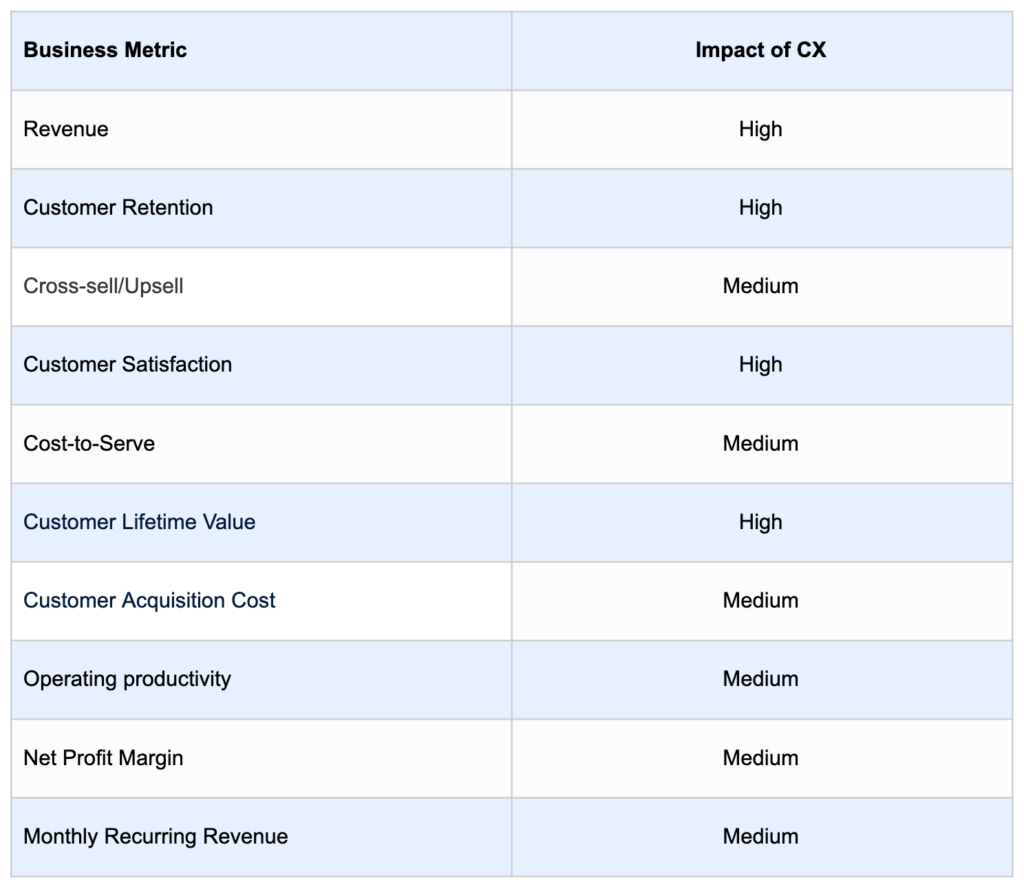
Let’s talk about a few of them in detail.
-
Revenue
One of the critical business metrics, top-line revenue is commonly considered the essential business metric to evaluate the ROI of your CX. Also, there are many reputable sources that share great insights on it and can be used by CX professionals to support their case.
Also, Forrester publishes a CX quality benchmark of large global brands called Forrester’s Customer Experience Index™ stating that the big companies of certain industries can earn hundreds of millions of dollars of annual increment of revenue on a one-point increase in Forrester’s Customer Experience Index (CX Index™).
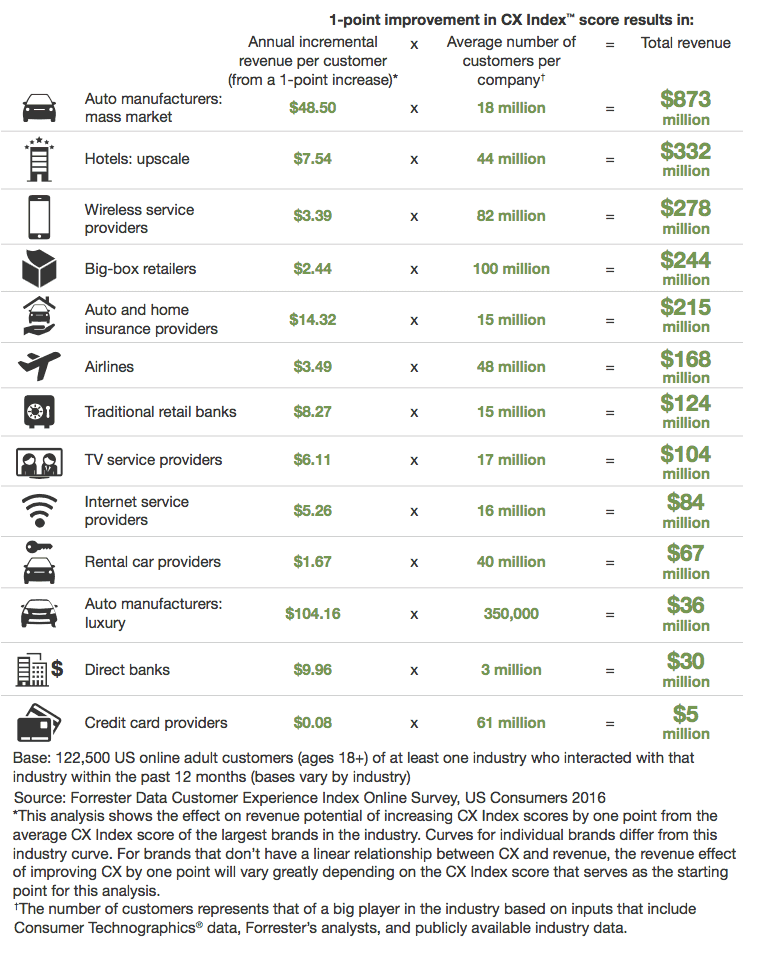
(Source: Forrester)
-
Customer Retention
In the age of personalization and customization, customers’ expectations have increased.
In fact, 59% of customers leave a brand after they had multiple bad experiences with it and 17% of the customers walk away just after one. The US companies are losing $136.8 billion per year due to poor customer experience.
Customer Experience and customer retention go hand in hand. If you improve your customer experience, you will directly increase your customer retention and reduce churn. There is a clear correlation!
Here’s an example of how a telecom company increased its revenue and retention by improving customer experience.
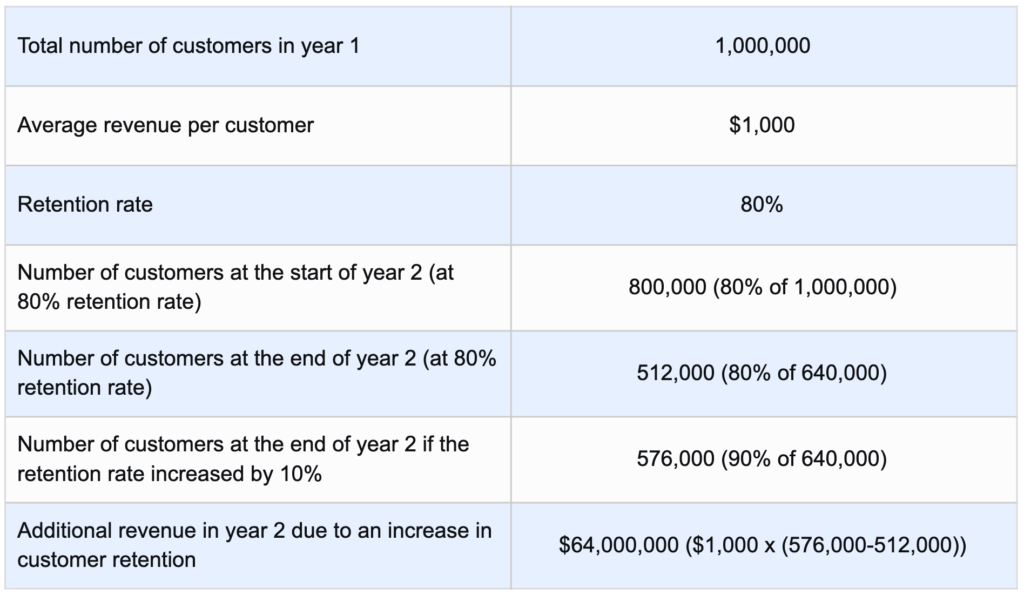
*For the sake of simplicity we have only considered the customers that have been retained and not any new customers.
So, in the above example, the retention rate at the end of year 2 is 80%. This means that out of 640,000 customers 512,000 customers stayed, which is really good.
Now after launching the CX program, the retention rate increased by 10% making it 90%. So, out of 600,000 customers, 576,000 customers stayed, which is even better.
If the average revenue per customer is $1000, the company gained an additional revenue of $64,000,000 in 2nd year.
All by increasing the customer retention rate by 10% which is awesome!!

Talking about calculating the ROI of your CX program, Dan Bailey, President at WikiLawn says, “Customer retention is a big one. If CX is performing very well, we expect to see an increase in customer retention rates, and with a subscription model, we can easily calculate the ROI of those retained customers.”
-
Customer Satisfaction
Customer experience has a direct impact on improving customer satisfaction. While some think that measuring the revenue from increased customer satisfaction is very difficult for ROI evaluation, it is not as difficult as it seems to be. You can calculate your revenue impact by using key satisfaction metrics such as CSAT, NPS, or CES.
The key is to determine what a one-point increase in CSAT score or Net Promoter Score means in terms of revenue.
That is the revenue impact of increased customer satisfaction.
For example, an e-commerce company we’ve recently worked with sent a CSAT survey to 10,000 customers and received 1,000 responses. Of those responses, 700 customers scored their experience a 4 or 5, 300 customers scored them a 3, and the remaining 100 scored them a 1 or 2.
So, their CSAT Score was 70%.
Now to calculate the revenue impact of a one-point increase in customer satisfaction, let’s assume that the average spend per customer is $500.

Now, the customer who chose 1 or 2 had an issue with the customer service live chat, and they improved it. Now, 750 customers scored 4 or 5 in their CSAT survey. 200 scored 3, and 50 scored 1 or 2.
Now the CSAT score has increased to 75%.
Let’s determine the impact of a 5% increase in the CSAT score.

This proves that the increase in CSAT score by just 5% saved them $63,000 per year.
-
Customer Lifetime Value
Customer Lifetime Value quantifies the total worth of a customer throughout the relationship. One of the most important metrics to measure, it indicates the total revenue you can expect from each customer.
Let’s say, every day you are buying a cup of coffee from the same cafe for the last 10 years. Though the coffee is worth only $10, your CLV is worth $36,520 for that cafe. And that’s a lot!
Also, as a referral client, you have ordered muffins, cakes, or croissants sometimes. You’ve also taken your friends over there. A few became regular customers and referred others to the cafe too, creating a chain. And once this chain of referral was created, the cafe saw explosive results. The number of footfalls increased, the number of transactions each month boosted, and the value of those transactions increased too.
And that’s what any business wants. Isn’t it?
-
Customer Acquisition Cost
Customer Acquisition Cost is the amount you are spending to acquire a new customer. It plays a critical factor while gauging the ROI. For example, if you are spending 20$ to acquire a new customer and the ROI you are getting is 1$, then you’re losing!
It is pertinent to make sure that your ROI is always high after the marketing efforts, operations efforts, technical costs, and other costs are taken into consideration.
Let’s say your average lead conversion time is 2 weeks and the average revenue per customer is $3,000. After launching the CX program, you listened to the customer and understood the problems they were facing.
You improved your customer support, enhanced product performance, and added new features to your product based on the voice of your customer.
After incorporating all the changes, the average lead conversion time was reduced to 3 days and the average revenue per customer became $3,300.
That’s what customer acquisition cost is all about, reducing the acquisition cost and increasing the revenue.
2. It’s your turn to choose the high-impact business metric
Now that you know about the business metrics, the next step would be to choose the business metric that is most impacted by your customer experience. Customer experience requires investments and serves many benefits, hence selecting the metric that can be measured alongside your CX investment is of paramount importance.
Defining the ROI and measuring the ROI can only be done by measuring the impact metrics. While choosing the impact metric, make sure that you serve the objectives of the ROI.
For example, if your business metric is customer satisfaction, you need to focus on the CSAT score across the customer journey at all touchpoints. Focus on customer satisfaction, churn rate, and retention across the journey. Make sure that your customer is satisfied at every milestone such as purchase, post-purchase, or support.
And make a point to review it weekly, twice a week, or once a month. Because if you are reviewing the progress after a year, your CX program is not going to give you any significant results.
Also, the impact metric is different for each department, be it marketing, sales, support, or product, and the CX leader overlooks the department making sure that the impact metrics of each department are aligned to serve the company’s goal.
3. Now, how will you calculate the ROI of your CX program?

You’ve successfully chosen your business metric and set your goals.
Now, let’s understand how can you calculate the ROI of your CX program with an example.
Here’s how one of our e-commerce customers boosted their ROI after they launched a CX program.
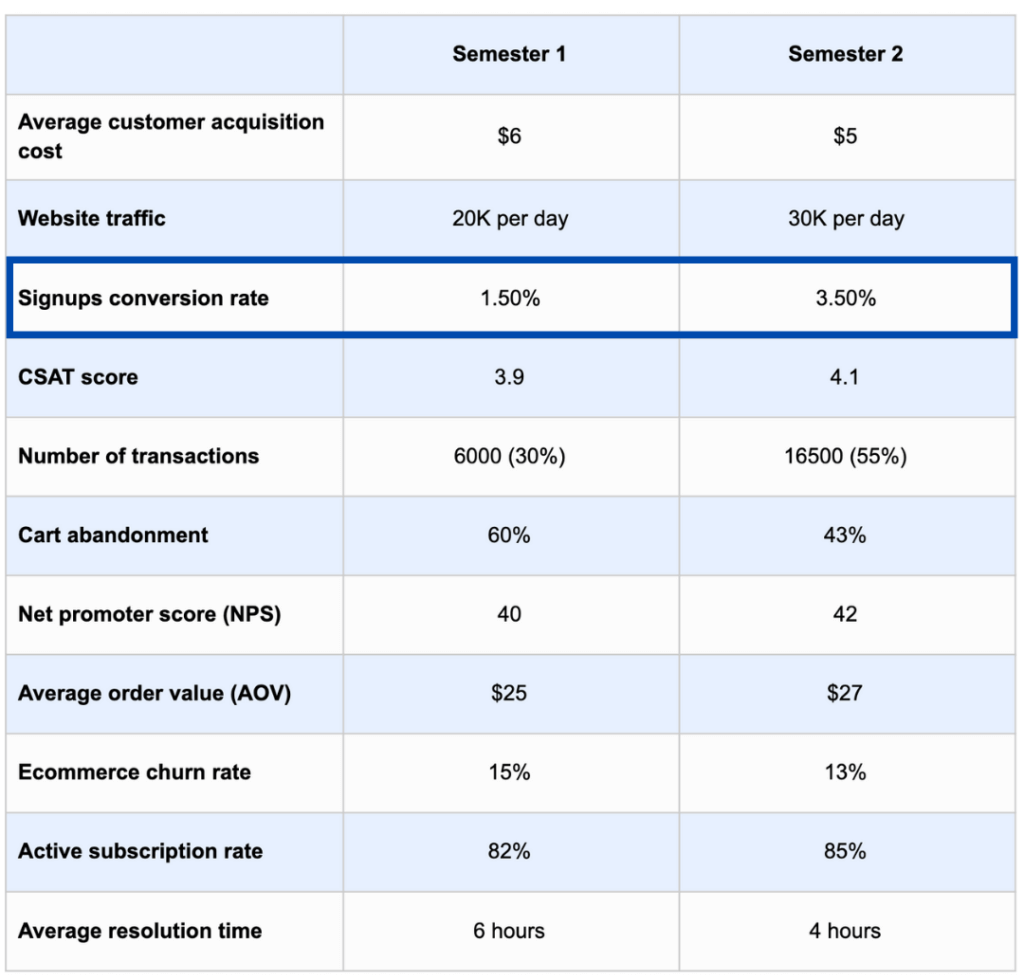
*We have simplified the numbers for easier understanding but they remain very close to the actual figures.
So, what did they do in these six months that their conversion rate doubled from 1.5% to 3.5%?
They invested in resources and technology!
They wanted to capture the customer feedback to understand the chat conversations and user behavior on the website. So, they invested $30,000 in SurveySensum’s feedback management and conversational analytics solutions.
This helped them in understanding customer sentiments and identifying the trends. What they analyzed was that the majority of their customers had troubles during the onboarding of the app and left out without even setting up an account. Their technical team resolved this issue in merely a few days and they were up and running.
The queries decreased and their conversion rate increased from 1.5% to 3.5% in six months. This led to an increase in the number of transactions from 30% to 55%.
Which is huge!
Their number of transactions in the first semester was 6,000 and the average order value was $25. This gave them a revenue of $150,000. After launching the CX program their number of transactions increased to 16,500 and the average order value increased to $27 increasing their revenue to $445,500.
The difference is $295,500.
Considering the $30,000 investment they did, they gained an additional revenue of $265,500 in just six months!!!

So everything is set and done. You know your business metrics, you know your goals, and you know how to calculate the ROI.
Let’s talk about CX investments now.
Here are some CX investments

Did you know that companies that earn $1 billion a year will see an average gain of $700 million within three years of investing in customer experience?
The investment newsletters varies for each business and its needs. I’ll talk about the two most common investments here.
-
Employee training
Customer experience and employees are correlated. If you are not focusing and investing in your employees, your CX will not improve. There is no loophole to it!
Focus on making your organization more customer-centric. Train your teams as per their respective departments. For example, train your customer service on the new changes in your product or services, customer support on how they can handle customer calls efficiently, and product team on the requirements of the customer.
Like Zappos has done it!
Zappos is obsessed with its customers. And they care for their employees too. Because let’s say it, without employee experience, there is no customer experience. They strongly focus on employee-customer relationships and their ‘Customer Service for Anything’ has taken their customer experience to the next level.
-
Advanced technology and tools

You need smart technology and intelligent tools to improve your customer experience. Automation is the key in today’s world. SurveySensum enables you to gather, gauge, and act on your customers’ valuable feedback all from one platform. This customer feedback and analytical solutions allow you to consolidate data in one place, visualize impact metrics from a single dashboard, give access to data to the stakeholders, manage the day-to-day activities, and share customer data with the team via role-based dashboards. At last, build a timeline and cost estimates for these investments.
Brett Downes, Founder of Haro Helpers made some investments on his website. He reduced to the checkout process to 3 steps directly impacting the customer journey and achieved 21.7% extra conversion and 30% fewer cart abandonments in a year.
He says. “Our checkout process was 5 steps. By investing in making the process more concise, and integrating guest checkout and social media logins we managed to reduce it to 3. With a progress bar to highlight to the consumer how far along they were in the process before their order was complete. We have seen some 21.7% increment in the conversions and 30% fewer car abandonments since investing in shortening out our checkout process”
Conclusion
We know that calculating the ROI of your CX program is a hard step. But it is the key to success.
You cannot launch a successful CX program without calculating the ROI. You just can’t!
The success of your CX program in terms of the business metrics is critical to get your peers on board and to get the investment you want to build a successful program.
So align your key business metric with your CX.
And if you are not doing it, you are running in a race with no goal!
I hope that the above article will help you in calculating the ROI of your CX program. Do share your experience with us!














